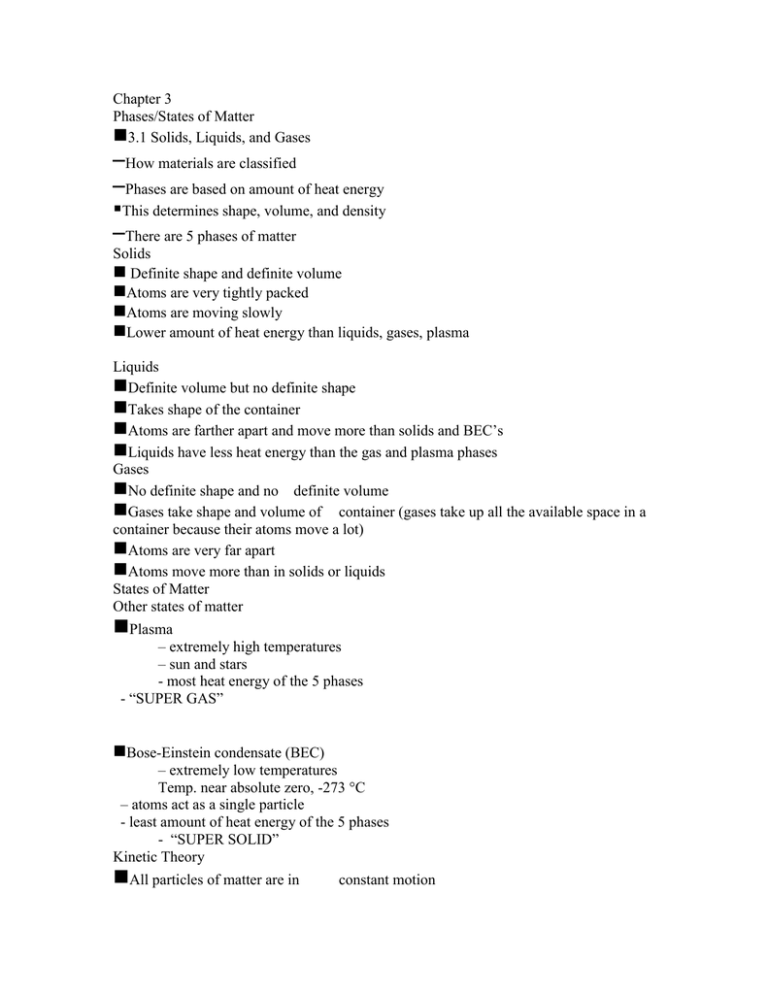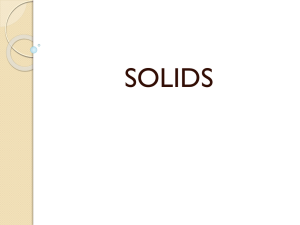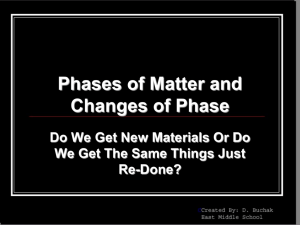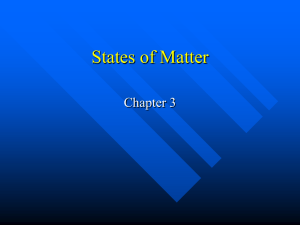–
advertisement

Chapter 3 Phases/States of Matter 3.1 Solids, Liquids, and Gases –How materials are classified –Phases are based on amount of heat energy This determines shape, volume, and density –There are 5 phases of matter Solids Definite shape and definite volume Atoms are very tightly packed Atoms are moving slowly Lower amount of heat energy than liquids, gases, plasma Liquids Definite volume but no definite shape Takes shape of the container Atoms are farther apart and move more than solids and BEC’s Liquids have less heat energy than the gas and plasma phases Gases No definite shape and no definite volume Gases take shape and volume of container (gases take up all the available space in a container because their atoms move a lot) Atoms are very far apart Atoms move more than in solids or liquids States of Matter Other states of matter Plasma – extremely high temperatures – sun and stars - most heat energy of the 5 phases - “SUPER GAS” Bose-Einstein condensate (BEC) – extremely low temperatures Temp. near absolute zero, -273 °C – atoms act as a single particle - least amount of heat energy of the 5 phases - “SUPER SOLID” Kinetic Theory All particles of matter are in constant motion Kinetic Energy – energy an Faster an object moves – the object has due to its motion greater its kinetic energy is Behavior of Gases Kinetic Theory of Gases –Particles are in constant, random motion –Motion of one particle is unaffected unless particles collide –Forces of attraction among particles in a gas can be ignored under ordinary conditions Behavior of Liquids Attraction between particles do affect their movement Liquid takes shape of container because particles can flow Volume is constant because forces of attraction keep particles closer together than gases Behavior of Solids Atoms have “fixed” locations Definite shape and volume because particles vibrate around fixed locations Atoms do not exchange places with neighboring atoms Sec. 3.2 The Gas Laws Pressure – the result of a force distributed over an area Collisions between particles of a gas and the walls of the container cause pressure. Factors that Affect Gas Pressure Temperature temperature = pressure temperature = pressure Volume – changing volume affects pressure - indirectly volume = pressure volume = pressure Number of Particles – affects pressure directly # particles = pressure # particles = pressure Charles’s Law States that the volume of a gas is directly proportional to its temperature in kelvins Direct relationship As temperature = volume As temperature = volume Boyle’s Law States that the volume of a gas is inversely proportional to its pressure Indirect relationship As volume = pressure As volume = pressure Sec. 3.3 Phase Changes Phase change – when a substance changes from one state to another a reversible physical change Six common phase changes – melting, freezing, vaporization, condensation, sublimation, and deposition Energy and Phase changes •During phase change – energy is transferred between substance and surroundings •Energy is either absorbed or released by the substance •HEAT ENERGY DRIVES ALL PHASE CHANGES!!! Endothermic change – substance absorbs energy from surroundings melting vaporiztion sublimation Exothermic change – substance releases energy to its surroundings freezing condensation deposition Melting and Freezing Melting: Solid Liquid Melting point – temperature at which melting occurs Water 0°C or 32°F Freezing: Liquid Solid Freezing point – temperature at which freezing occurs Melting points and freezing points are the same for a given substance Different substances have different melting & freezing points Vaporization and Condensation Vaporization – Liquid Gas Endothermic process – absorbs heat energy Two types – evaporation and boiling Evaporation – takes place on the surface and at temperatures below boiling point Boiling – vapor pressure = atmospheric pressure: adding lots of heat Water boils at 100°C or 212°F Condensation – Gas Liquid –Exothermic process – heat energy is released –Ex. bathroom mirror after a shower, morning dew Sublimation – Solid Gas –Endothermic process – heat energy is absorbed –Ex. Dry ice CO2 Deposition – Gas Solid oExothermic process – heat energy is released oOpposite of Sublimation o Ex. Carbon dioxide – CO2





